MARIANI’S
Virtual
Gourmet
December
31, 2017
NEWSLETTER

HAPPY NEW YEAR!
❖❖❖
IN THIS ISSUE
MÁLAGA, Part Three
By Gerry Dawes
NEW YORK CORNER
UPLAND
By John Mariani
NOTES FROM THE WINE CELLAR
DESSERT WINES
BY John Mariani
❖❖❖
MÁLAGA, Part Three
By Gerry Dawes
Photos © Gerry Dawes (2017)

Málaga Antigua Casa de Guardia
On my second day in Málaga, I set out in the morning to tour the Old City. My memories of the Mercado de Atarazanas and the authentic old wine bodega-tavern La Antigua Casa de Guardia from my cruise ship excursion a decade earlier put return visits to both high on my list.
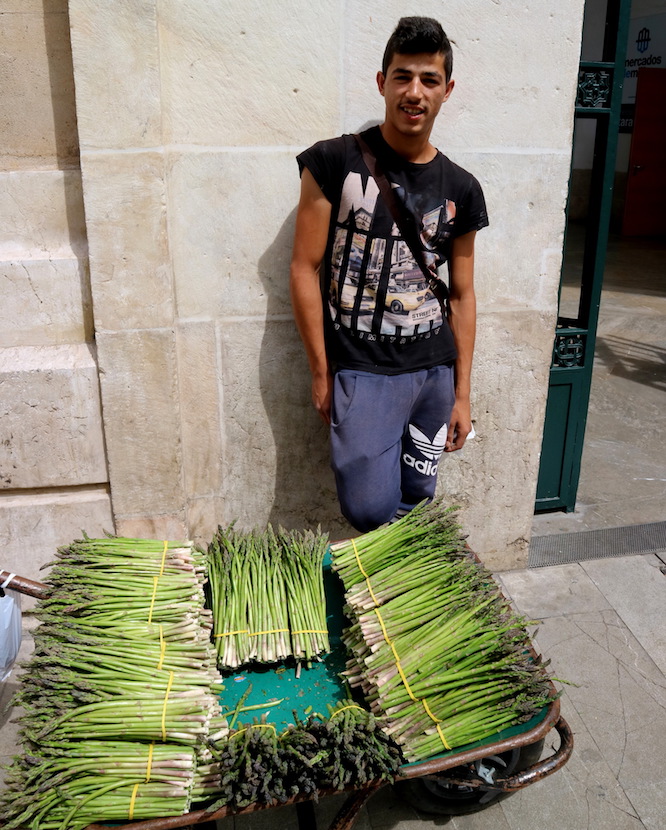 At
the entrance to the market a young man was selling
from a cart big bunches of esparragos
trigueros (left),
thin wild green asparagus that is often served a la plancha grilled,
drizzled with Spanish Extra Virgin Olive Oil and a
sprinkling of sea salt, or cut into pieces,
sautéed and put together with shrimp into tortillas de
esparragos
trigueros y gambas. Inside
the market was a cornucopia of Spanish food
products, many unique to the region of Andalucía
and to the province of Málaga.
At
the entrance to the market a young man was selling
from a cart big bunches of esparragos
trigueros (left),
thin wild green asparagus that is often served a la plancha grilled,
drizzled with Spanish Extra Virgin Olive Oil and a
sprinkling of sea salt, or cut into pieces,
sautéed and put together with shrimp into tortillas de
esparragos
trigueros y gambas. Inside
the market was a cornucopia of Spanish food
products, many unique to the region of Andalucía
and to the province of Málaga.
At one fish stand the owner keeps moving around
his remaining silvery fresh anchovies (boquerones)
into Picasso-esque three-fish triangles, the same
way it was done at this stand when I photographed
it ten years ago.
Also typical here are búsanos,
a type of predatory rock sea snail from the Bay of
Málaga, once highly prized in ancient Phoenicia
and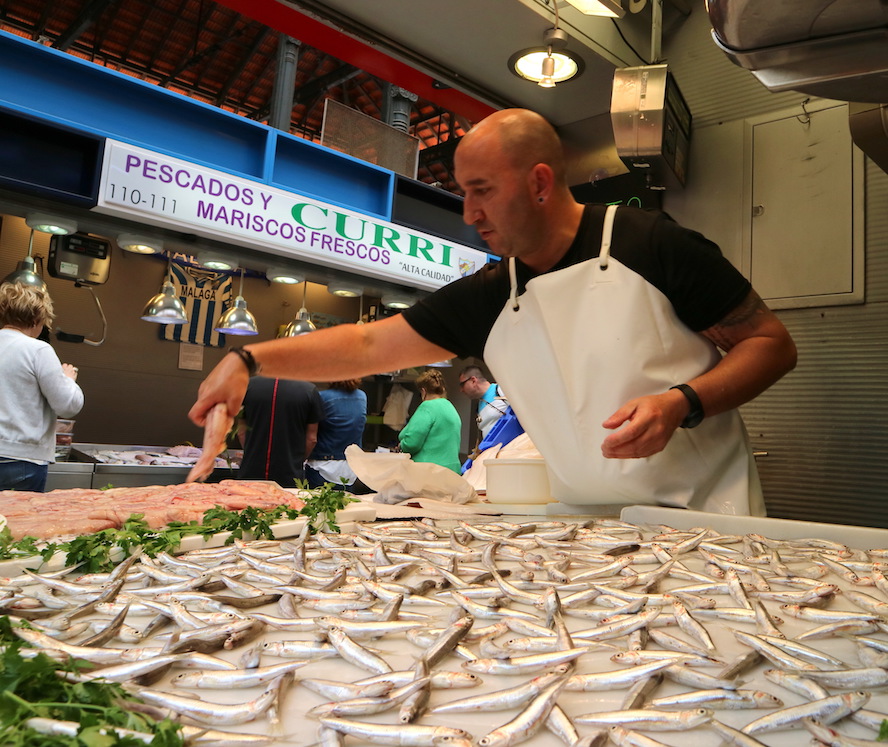 in Rome
because extracted secretions from these snails
yielded the famous, and very expensive, “royal”
purple dye for clothing.
in Rome
because extracted secretions from these snails
yielded the famous, and very expensive, “royal”
purple dye for clothing.
Cheese
stands
feature quesos
de cabra (goat’s cheeses) soaked in Málaga
Moscatel wine and excellent goat’s and sheep’s
milk cheeses from up-and-coming producers in the
Sierras de Málaga.
Those same goats provide their meat for chivo de
Málaga, kid goat sold in the butcher shops,
along with freshly made and cured chorizos, morcilla
de Ardales
blood sausage and others hanging alongside jamón Ibérico
de bellota hams from acorn-fed pigs from
Jabugo in the mountains of Huelva in Western
Andalucía.
There are also fresh
Ibérico pork cuts called secreto,
pluma,
presa and lagarto.
Pasas de Málaga (Moscatel grape raisins), dried orejones (apricots),
dátiles
(dates), toasted almendras
(almonds), sticks of canela
(cinnamon), local almendras
(almonds), avellanas
(hazelnuts), nueces
(walnuts) and castañas
(chestnuts) are all available in the frutos secos
(dried fruits and nuts) stands. Spice stands have
bags full of bright carmine pimentón (exquisite
sweet, smoked or picante
paprika, the best of it from La Vera in
Extremadura and Murcia); scoops of dried orégano;
comino
(cumin); fresh and dried tomillo
(thyme) and romero
(rosemary) pulled from the sierras; azafrán
(saffron, much of it now from Iran) and strings
and bulbs of garlic.
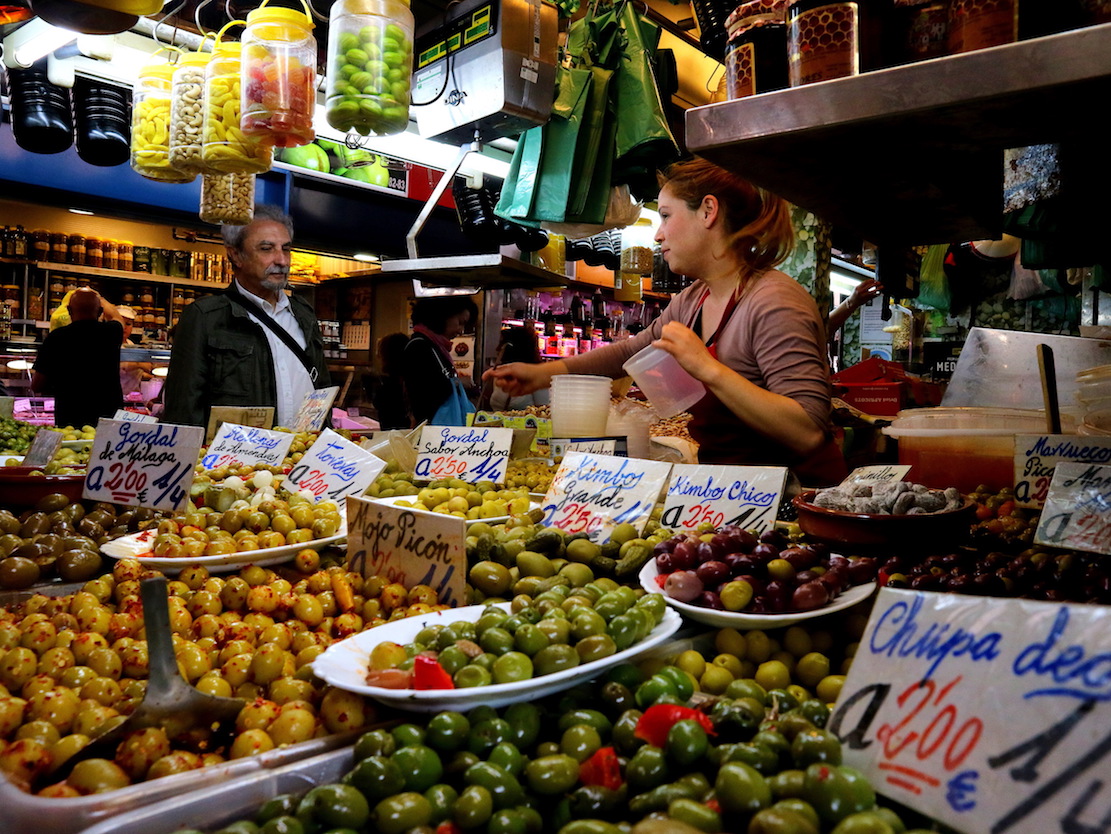 Amazing
Aceitunas Bravo offers a dazzling array of aceitunas
olives (left):
fat green olives called gordales,
both brined and cured with anchovies; green and
ripe Manzanilla olives, others called kimbos, chupo dedos
(finger-licking), rellenas de
almendras, ajos or pimientos
(stuffed with almonds, garlic or pimientos); new
harvest green olives from nearby Álora and picante
Moroccan olives.
Atarazanas market bars offer típico
tapas such as migas (below),
a very Andalucian paisano
dish of bread crumbs sautéed with chorizo, here
served with a fried egg and a fried green pepper,
sometimes served with grapes. But it
was the vieiras
(sea scallops) at Casa Guirado
Marisquería-Freidura (shellfish-and-fried fish
specialist) that caught my attention.
Amazing
Aceitunas Bravo offers a dazzling array of aceitunas
olives (left):
fat green olives called gordales,
both brined and cured with anchovies; green and
ripe Manzanilla olives, others called kimbos, chupo dedos
(finger-licking), rellenas de
almendras, ajos or pimientos
(stuffed with almonds, garlic or pimientos); new
harvest green olives from nearby Álora and picante
Moroccan olives.
Atarazanas market bars offer típico
tapas such as migas (below),
a very Andalucian paisano
dish of bread crumbs sautéed with chorizo, here
served with a fried egg and a fried green pepper,
sometimes served with grapes. But it
was the vieiras
(sea scallops) at Casa Guirado
Marisquería-Freidura (shellfish-and-fried fish
specialist) that caught my attention.
I moved on to
explore more of the city. La Plaza de
la Constitución, with its fountain in the
center, shops, sidewalk cafés and a maze of Old
Quarter streets is one of the main pedestrian
crossroads of the city. Around every turn is a new
discovery, a unique shop,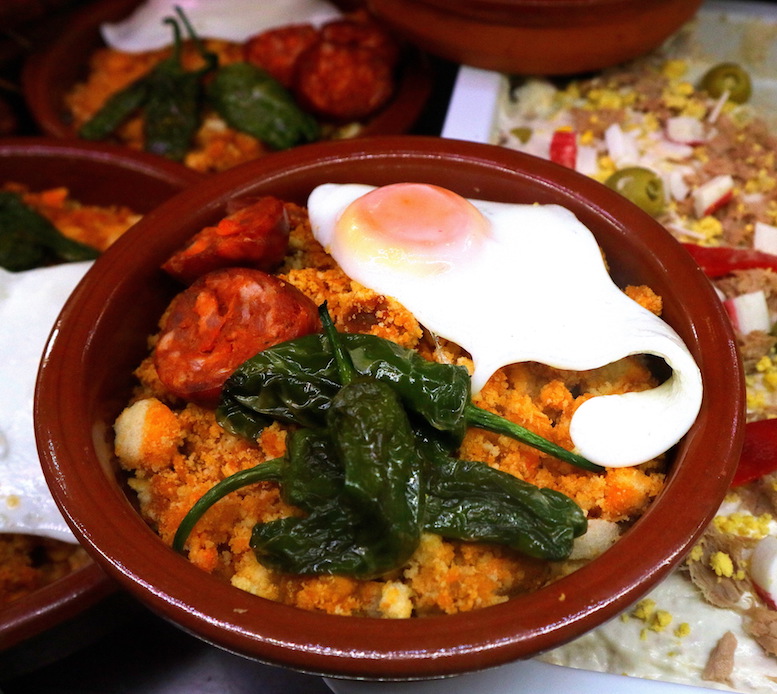 a
centuries-old church, a museum and a multitude of
typical Málaga tapas-bar/restaurant with indoor
and outdoor seating with awnings and umbrellas to
shield patrons from the southern sun. Hand-painted,
tiled plaques and artistically done signs announce
such uniquely Málagan places as El Piyayo, La
Bodeguita de Málaga, El Pimpi, El Chinitas, Casa
Lola and El Patio.
a
centuries-old church, a museum and a multitude of
typical Málaga tapas-bar/restaurant with indoor
and outdoor seating with awnings and umbrellas to
shield patrons from the southern sun. Hand-painted,
tiled plaques and artistically done signs announce
such uniquely Málagan places as El Piyayo, La
Bodeguita de Málaga, El Pimpi, El Chinitas, Casa
Lola and El Patio.
I made a passing acquaintance with Antonio, a sun-baked middle-aged man selling toasted and candied almendras from a cart just off the plaza. I bought a bag, stashed it for later, then moved on to encounter a busy tapas bar, Pepa y Pepe, where I sat at an upended barrel and ordered a draft beer and a favorite dish, puntillitas fritas (deep-fried whole baby squid).
On my Old Quarter peregrinations I encountered specialty food shops, including la Mallorquina, well stocked with hanging jamones Ibéricos and sausages, cheeses, and northern Spain’s stellar canned seafood products.
Near Atarazanas is maestro panadero (baker) Antonio García’s El Colmenero de Alhaurín el Grande, the Málaga outpost of his famous bakery-cum-bakery museum in the town of Alhaurín el Grande northwest of the city. And along the way there were stores selling from open baskets especies morunas for pinchitos (Moorish lamb skewers), especias caracoles (spices for flavoring snails) and pimentón (paprika) by weight.
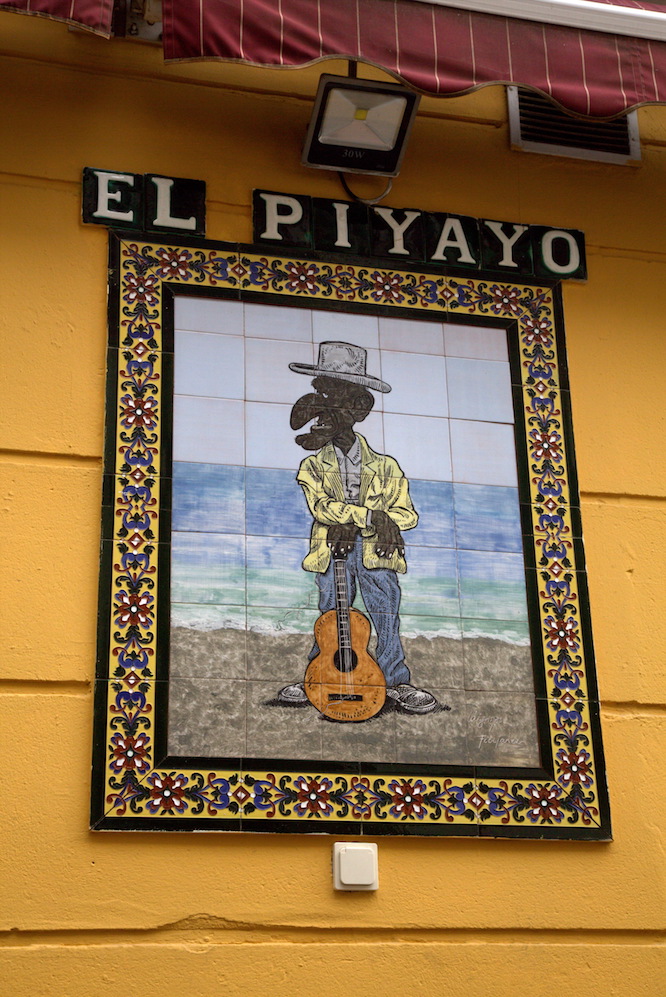 La
Antigua Casa de Guardia is a
not-to-be-missed 19th century Málaga wine bodega,
founded in 1840 by Don
José Guardia, lined with rows of ancient
barrels.
Veteran barmen stand ready to draw copitas
(cylindrical glasses holding 2-3 ounces) of stout
sweet or semi-sweet Vino de Málaga directly from
the barrels and to serve them with a variety of
tapas, including pinchos de
boquerones with a pickle and pearl onions, conchas-almejas
(large clams on the half shell), steamed mejillones
(mussels), superb shell-on langostinos
(prawns), local queso de
cabra (goat’s cheese), chorizo and olives. Running
cuentas
(tabs) are kept old-style, scribbled in chalk on a
series of side-by-side rectangular wooden tables
that make up the bar.
La
Antigua Casa de Guardia is a
not-to-be-missed 19th century Málaga wine bodega,
founded in 1840 by Don
José Guardia, lined with rows of ancient
barrels.
Veteran barmen stand ready to draw copitas
(cylindrical glasses holding 2-3 ounces) of stout
sweet or semi-sweet Vino de Málaga directly from
the barrels and to serve them with a variety of
tapas, including pinchos de
boquerones with a pickle and pearl onions, conchas-almejas
(large clams on the half shell), steamed mejillones
(mussels), superb shell-on langostinos
(prawns), local queso de
cabra (goat’s cheese), chorizo and olives. Running
cuentas
(tabs) are kept old-style, scribbled in chalk on a
series of side-by-side rectangular wooden tables
that make up the bar.
On the wall above the barrels is a famous photo by
Hungarian photographer Gyenes János (1912-1995),
known in Spain as Juan Gyenes, of Pablo Picasso in
France with the late flamenco dancer Antonio El
Bailarín gifting the artist a garrafa
jug of Málaga Moscatel from Casa de Guardia. 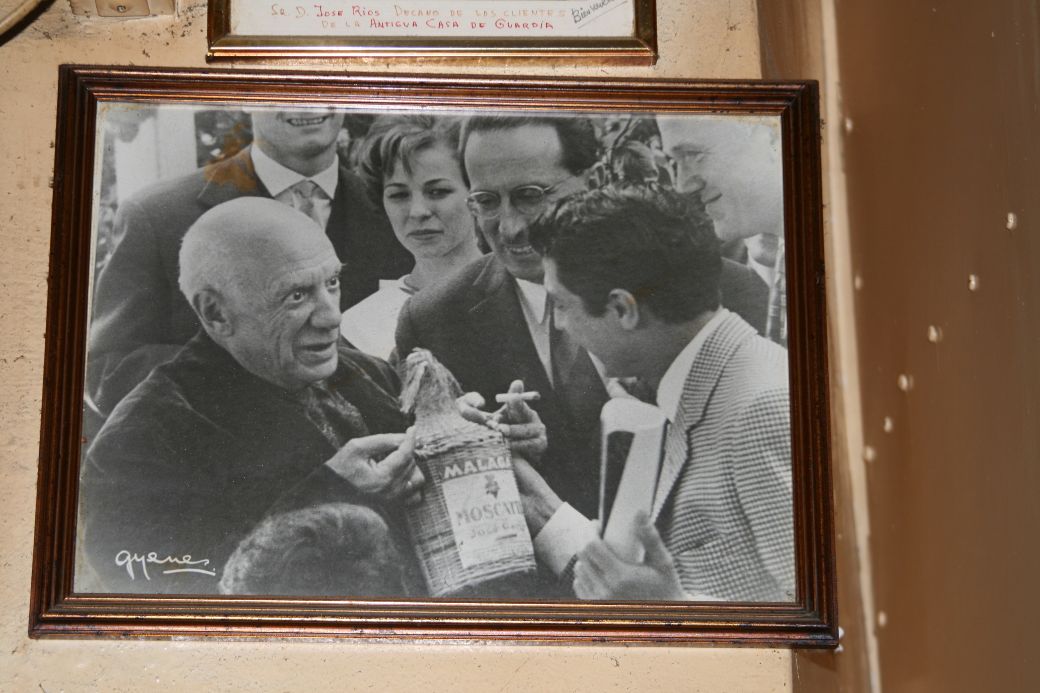
In the afternoon I met fellow journalists on a
guided tour of the superb Picasso
Museum, many of whose works were donated by
Christine and Bernard Ruiz-Picasso, Picasso’s
daughter-in-law and grandson. If
you are a fan of Picasso, this museum, in a lovely
two-storied building with a blend of Renaissance
and Mudéjar elements and a patio, would likely
make the trip to Málaga well worthwhile even if
the city lacked any other attractions. And
beneath the museum, excavations have uncovered
important Phoenician, Roman and Moorish remains,
including fragments of the 7th century Phoenician
walls and remains of a Roman garum (the
prized umami-rich fermented fish sauce) and mojama
(dried-and-salted fish) factory.
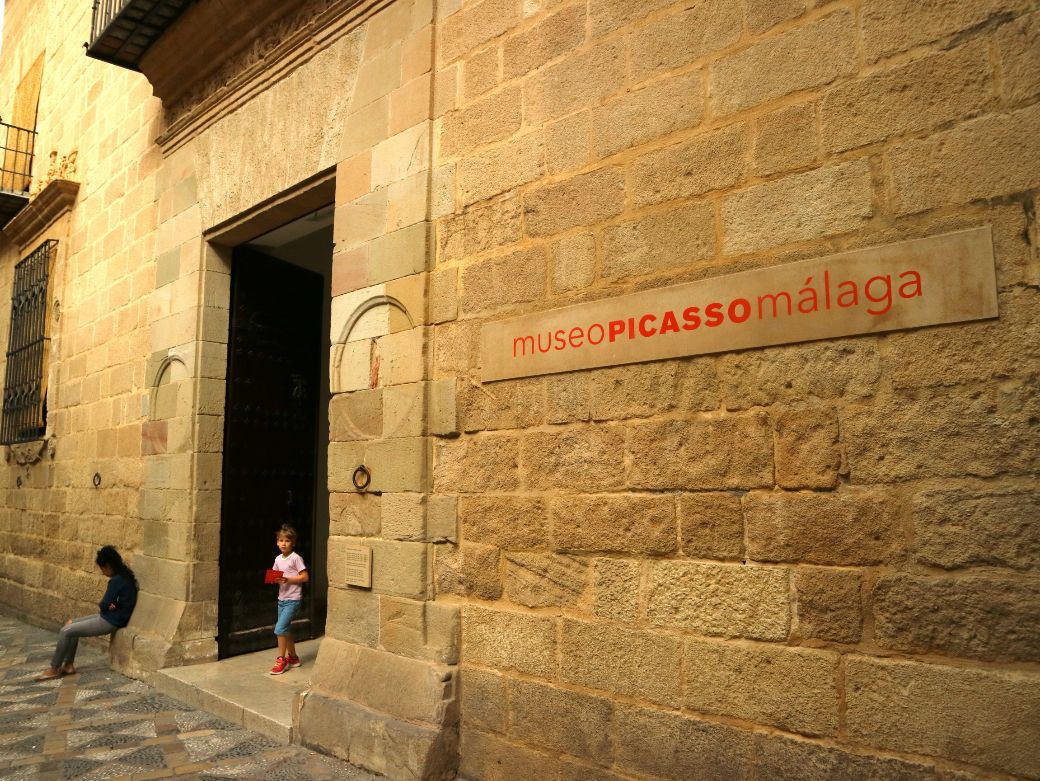 Before
dinner,
we strolled along the nearby pedestrian calle
Alcazabilla alongside the Roman theater beside the
11th century Alcazaba fortress. A movie theater
dates to 1945, its architecture based on Santa
Barbara, California-style Spanish buildings. Also
along this street is a famous terrace
bar-restaurant-bodega, the legendary El Pimpi,
and the glassed-in excavation of the vats of
another garum
factory. There is also a Garum
Restaurante that serves a modern version of
this pungent, fermented fish sauce.
Before
dinner,
we strolled along the nearby pedestrian calle
Alcazabilla alongside the Roman theater beside the
11th century Alcazaba fortress. A movie theater
dates to 1945, its architecture based on Santa
Barbara, California-style Spanish buildings. Also
along this street is a famous terrace
bar-restaurant-bodega, the legendary El Pimpi,
and the glassed-in excavation of the vats of
another garum
factory. There is also a Garum
Restaurante that serves a modern version of
this pungent, fermented fish sauce.
Gerry Dawes was
awarded the Spanish National Gastronomy Prize.
He plans and leads customized gastronomy, wine
and cultural trips to Spain.
❖❖❖
By John Mariani
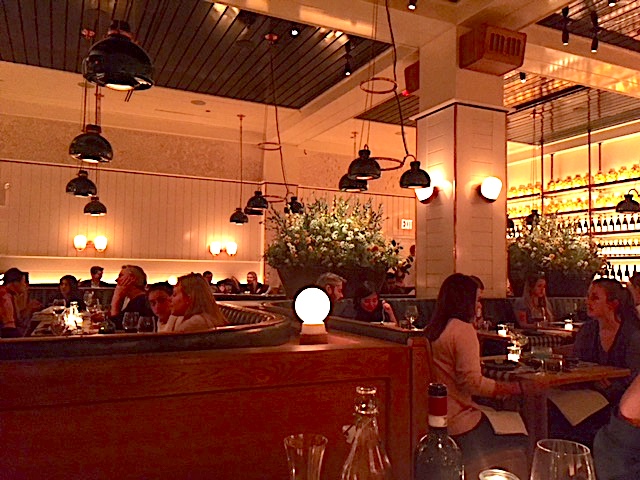 UPLAND
UPLAND345 Park Avenue South (near 26th Street)
212-686-1006
For three years now, Upland, named after Chef Justin Smillie’s hometown in California, has been full every night until about nine o’clock, with a solid bar and dining crowd by six. It’s a vast restaurant with tall walls holding wines and jars of lemons, and, since it’s pretty loud throughout, without any real soft surfaces, I commend owner Stephen Starr for not pumping in any kind of music that would cause a more intense din than it is.
It’s a very casual restaurant, and I think every guy in the place (except me) was in a t-shirt. The waiters wear gingham aprons, which seems a tad cute for NYC, but Uplands is in some way supposed to have a California vibe and menu. The former is arguable, the latter difficult to discern.
Smillie has shown far more of an affinity
to Italy in his past work in NYC, at Il Buco
Alimentari e Vineria, and he has retained a
number of dishes from that restaurant’s menu,
including
bucatini cacio e pepe and pepper-crusted
short ribs—both very good dishes. 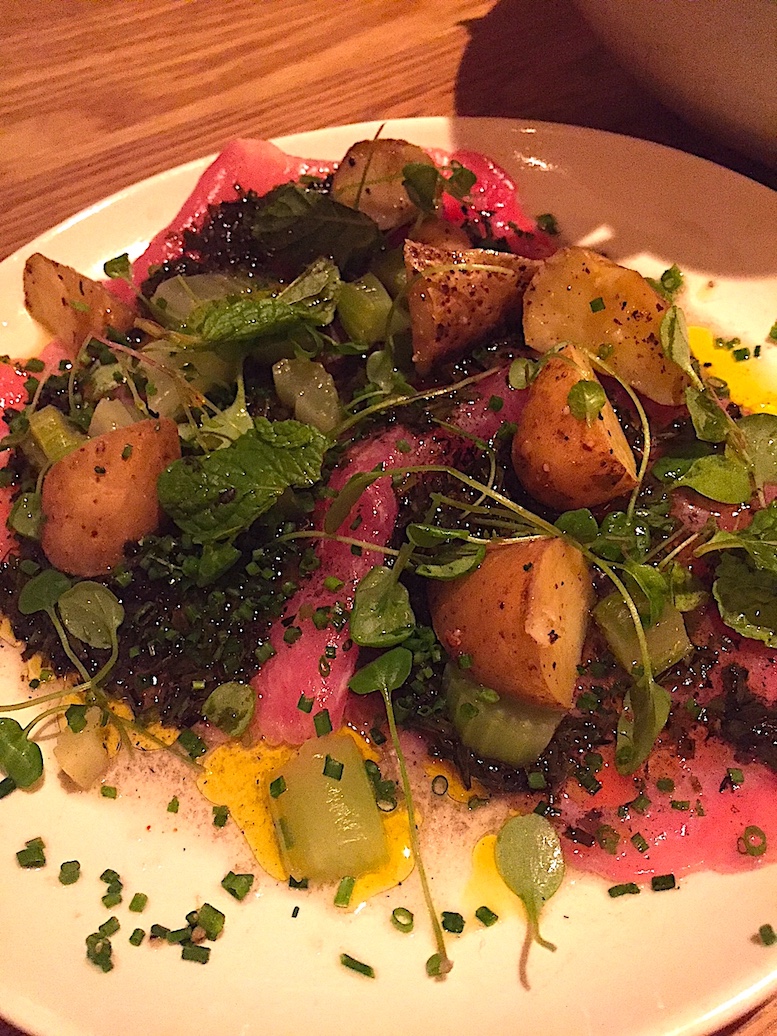 The rest of
the menu has a savory Italian cast, but as far
as I can figure, few items have ever left it and
there are no nightly specials.
The rest of
the menu has a savory Italian cast, but as far
as I can figure, few items have ever left it and
there are no nightly specials.
Sadly, the kitchen has a very heavy hand with salt, a mistake that can occur when too many guests have to be served at prime time. (Our three-course meal, which we said we’d all like to share at our table for four, took a very long three hours to cook and serve.) When cooks are not tasting every dish that goes out and the kitchen is “in the weeds,” reaching for the salt is almost a reflex action and it shows in way too many dishes at Upland.
 The ‘nduja—a
very spicy sausage condiment—tends to be salty,
so it should have been used more sparingly on a
pizza with a pureed passata
tomato sauce (pricey indeed at $21). So,
too, the delicacy of tuna carpaccio (right) was
upended with too many ingredients added to it,
including pickled celery, fingerling potatoes
and a charred chive vinaigrette ($22). A
dish that’s been a hit apparently since day one
is a whole crispy hen of the woods mushroom
($21) that reminded me of the “Bloomin’ Onion”
at an Outback Steak House, and like that item
took most of its flavor from the frying oil (left, with ribs).
The ‘nduja—a
very spicy sausage condiment—tends to be salty,
so it should have been used more sparingly on a
pizza with a pureed passata
tomato sauce (pricey indeed at $21). So,
too, the delicacy of tuna carpaccio (right) was
upended with too many ingredients added to it,
including pickled celery, fingerling potatoes
and a charred chive vinaigrette ($22). A
dish that’s been a hit apparently since day one
is a whole crispy hen of the woods mushroom
($21) that reminded me of the “Bloomin’ Onion”
at an Outback Steak House, and like that item
took most of its flavor from the frying oil (left, with ribs).
Seared octopus with cilantro-avocado pesto, Calabrian chili and Marcona almonds ($25) was a good appetizer; yet again a serious dose of salt overpowered an already spicy dish of crispy duck wings with lemon, olive oil and yuzu kosho—an intense Japanese chile and salt condiment ($19).
That bucatini cacio e pepe ($20) was very good and classically prepared with crushed black pepper and good pecorino, but—I hate to keep harping on this—saltiness corrupted the flavor of a pasta with chopped up chicken liver, sherry, rosemary and sage ($22)—so much I could barely taste the livers.
Despite its unappealing presentation, the best
of the entrees was a roasted branzino
for two with fennel and leek vinaigrette ($72),
and a grilled chicken with sweet 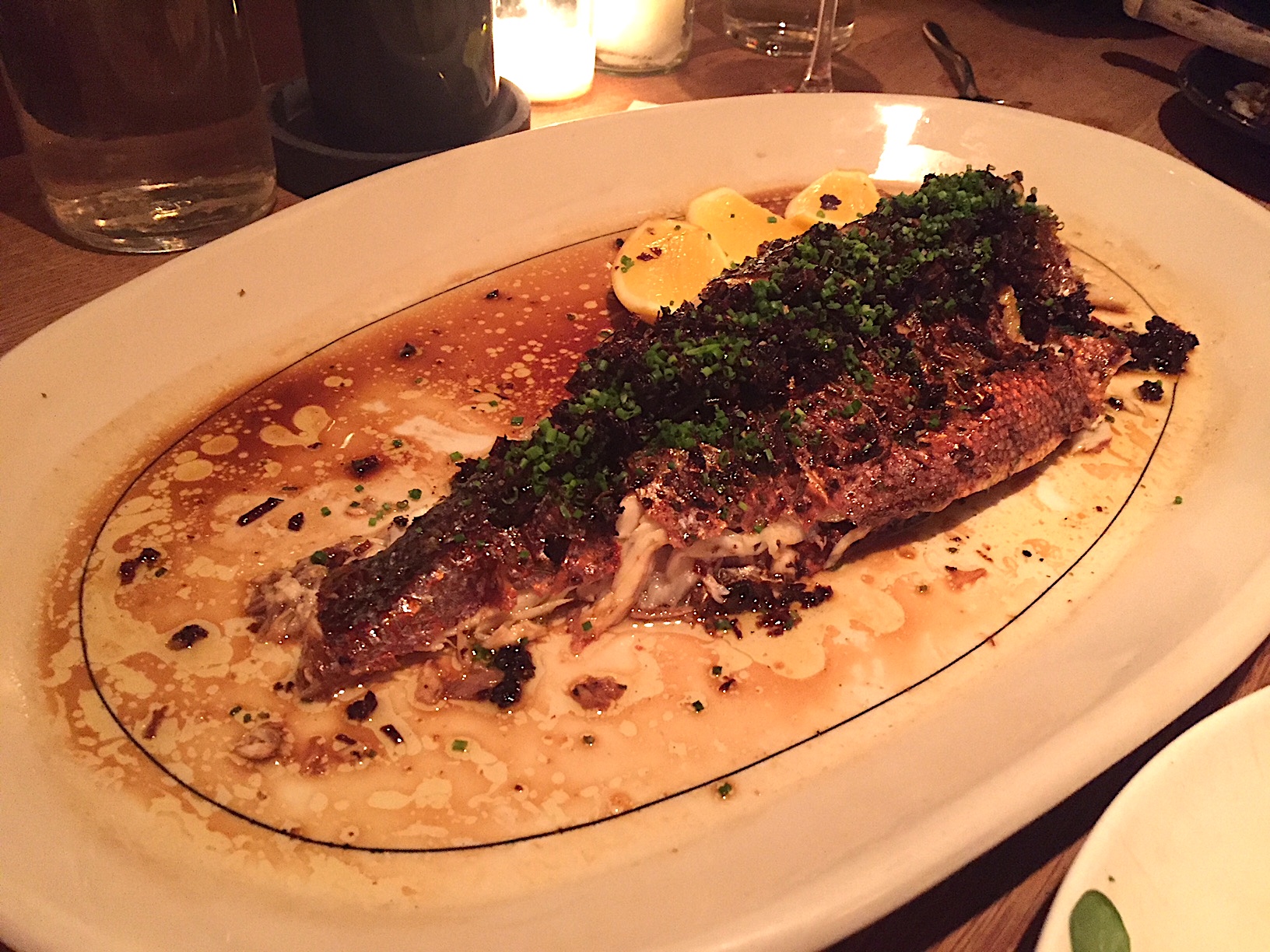 Niagara grapes,
pistachio, mint and goat’s cheese ($32) worked
well. Suckling pig porchetta ($26)
reverted to saltiness, combined with heirloom
beans, roasted tomatoes and bok choy. I would
have liked more of the crackling skin.
Niagara grapes,
pistachio, mint and goat’s cheese ($32) worked
well. Suckling pig porchetta ($26)
reverted to saltiness, combined with heirloom
beans, roasted tomatoes and bok choy. I would
have liked more of the crackling skin.
Out of steam after more than three hours, we tasted two desserts, a pretty fair apple tart ($14) and milk & cookies ($14), which were pretty wonderful. (Has anyone noticed dessert prices are going through the clouds these days?)
You can wholly depend on sommelier Nikky Ledbetter to find a perfect wine for your order and budget from an excellent and substantial list.
Stephen Starr is a masterful restaurant conceptualizer, and each of his venues in NYC are well focused: Buddakan=Asian; Morimoto=Japanese; The Clocktower=British; El Vez=Mexican; and Le Coucou=French. Upland lacks such a defined personality. It’s a chummy, laid-back place—I guess that’s where the California vibe comes in—but the menu is all over the place and the kitchen seems to be coasting and finding it hard to get the food out on time. Slow down, taste each dish, and maybe everything will be all that much better.
❖❖❖
DESSERT WINES
By John Mariani

CHÂTEAU D'YQUEM, BORDEAUX
It is one of the ironies of the wine world that so many people believe that sweet wines are cheap plonk drunk from bottles in a brown paper bag, while connoisseurs consider so many sweet wines to be among the greatest in the world, as well as the most expensive.
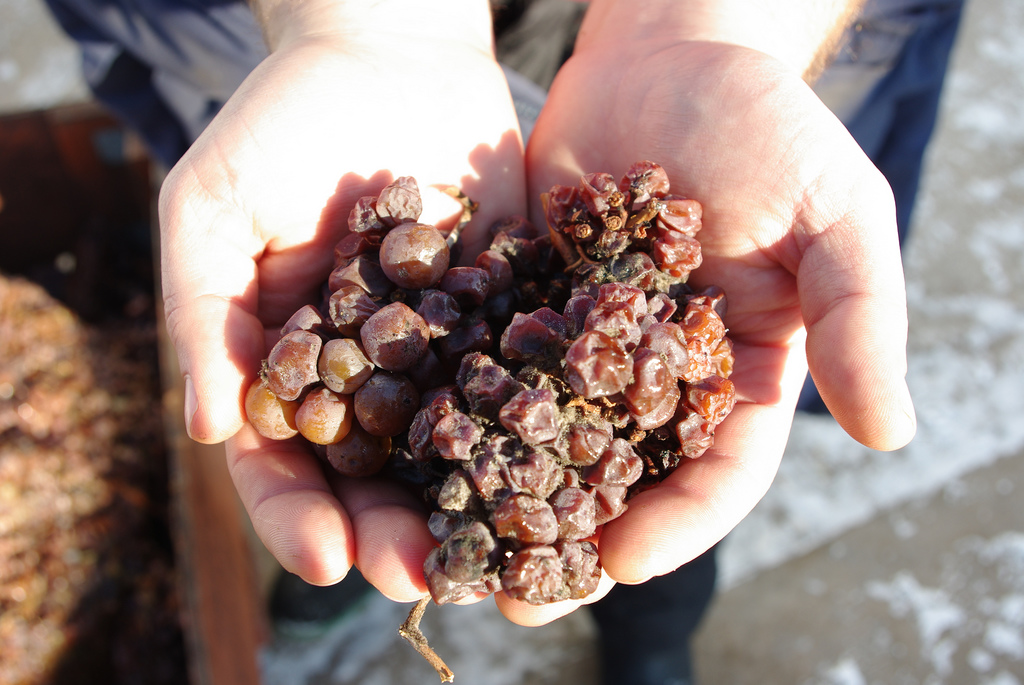 To be sure, there
is plenty of cheap sweet plonk on the shelves, but
increasingly there is a wider array of wonderful
dessert wines, some very expensive, some remarkably
inexpensive, that provide enormous pleasure with
dessert, or as dessert itself. These
wines are now coming in from all over the globe,
including the great Sauternes of France and the
exquisite ultra-sweet trockenbeerenauslesen
rieslings of Germany along with Tokay from Hungary,
ice wines from Canada and late-harvest varietals
from California.
To be sure, there
is plenty of cheap sweet plonk on the shelves, but
increasingly there is a wider array of wonderful
dessert wines, some very expensive, some remarkably
inexpensive, that provide enormous pleasure with
dessert, or as dessert itself. These
wines are now coming in from all over the globe,
including the great Sauternes of France and the
exquisite ultra-sweet trockenbeerenauslesen
rieslings of Germany along with Tokay from Hungary,
ice wines from Canada and late-harvest varietals
from California.
Sauternes from Bordeaux—not the stuff called “Sauterne” on American labels—is a very difficult wine to make: The Semillon grapes undergo the tricky process first being attacked by a fungus called Botrytis cinerea that rots the grapes (left), devouring five-sixths of the acids and one-third of the sugars. But this so-called “noble rot” also concentrates the remaining water and sugar into a pulp that, after fermentation, results in an intensely luscious, balanced wine of between 17.5 and 26 percent alcohol.
Yield is always very low. The time-consuming, careful, selective picking of the grapes means only a portion of them will actually go to the winery, and the best Sauternes producers make only 60 to 90 cases per acre a year. There are also years when the entire crop might be lost to rot.
All of which should make Sauternes very, very expensive. But, while no one denies the supremacy of the famous Château d’Yquem, which can sell for hundreds of dollars per bottle, at least half a dozen other Sauternes estates battle it out each year for second honors and are among the best bargains in French wine. You can find a First Growth like Château Lafaurie-Peyraguey in a half-bottle for about $30; The esteemed Château Suduiraut is only $20 and La Tour Blanche sells for about $20.
A glass of Sauternes with foie gras is a
match-up now ubiquitous in fine dining rooms, and
serving ice cold Sauternes with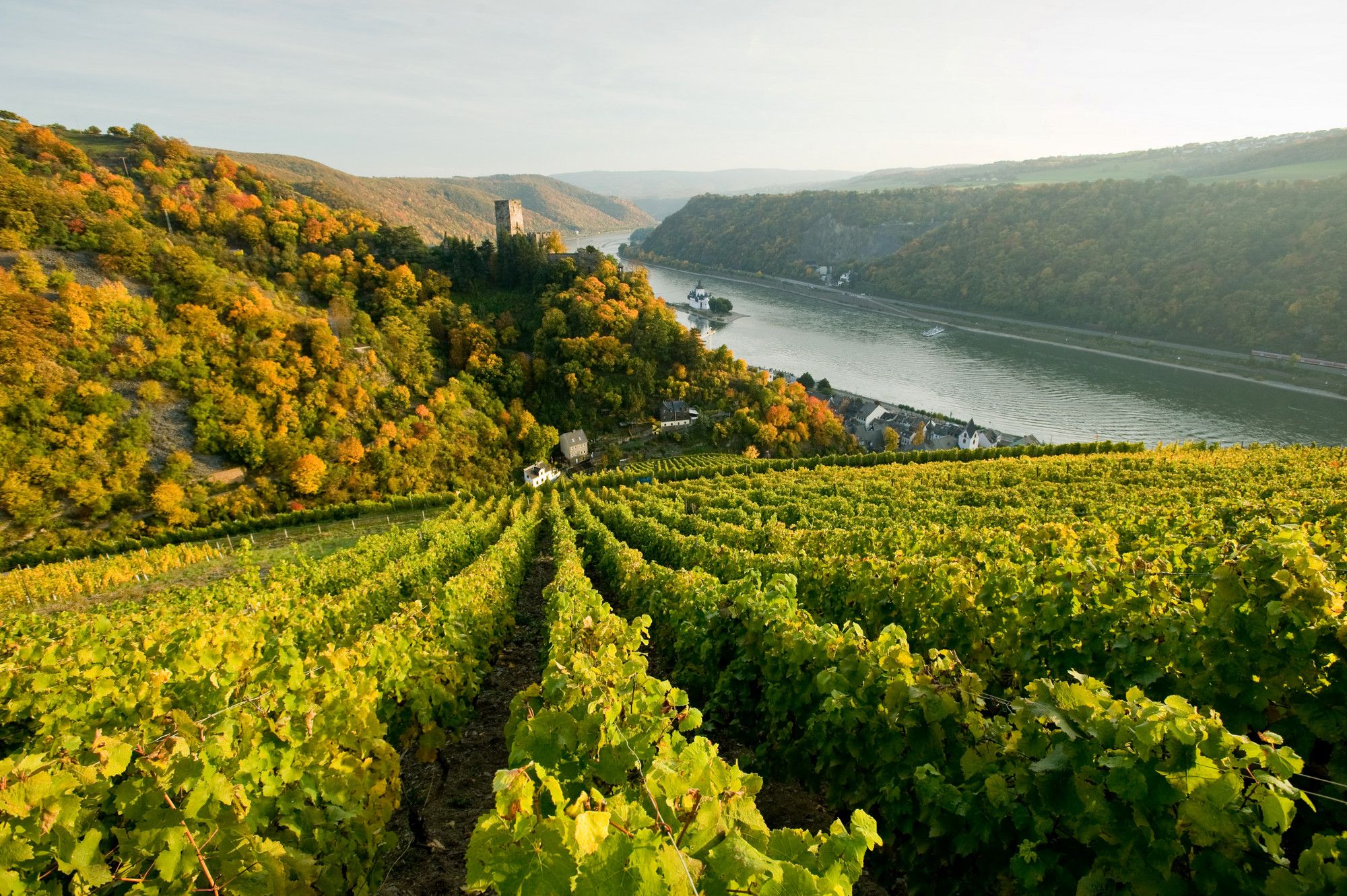 Roquefort
is considered a classic marriage.
Roquefort
is considered a classic marriage.
The greatest wines of Germany are rieslings from the Rhine Valley (right), and the greatest of those are the intensely concentrated beerenauslesen (“berry selection”) and trockenbeerenauslesen (“dried berry selection”), also attacked by the noble rot. The best can age for decades, acquiring a burnt caramel flavor while retaining the floral spice of the Riesling grape. Beerenauslesen wines can be found for under $70 and trockenbeerenauslesen can exceed $100.
Even sweeter are ice wines (eisweins in Germany), and some of the most wonderful now are made by the Inniskillin winery in Canada. They are remarkable, almost cordial-like wines best enjoyed all by themselves, or perhaps with just some hot roasted chestnuts.
Similar in quality and sometimes even more velvety are the Tokays of Hungary, made from the Furmint grape. Under Soviet control the Hungarian vineyards withered, but they have been restored, largely from foreign investment, and the Tokays are now sold internationally. Look for the stars on the bottle called “puttonyos,” with five being the sweetest and most treasured, available in a full bottle for about $70, though the much-prized Essencia can go for $500 and up.
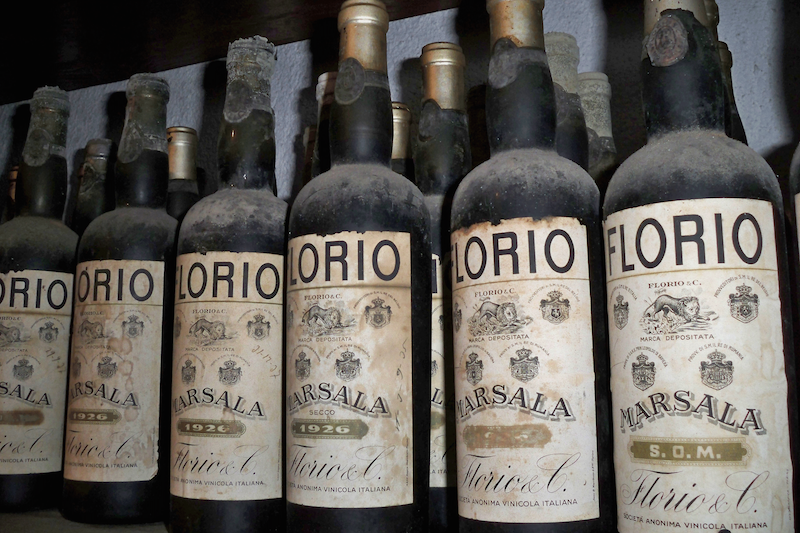 Italy
makes some superb sweet wines, from the light but
luxurious Picolit from Friuli to the dark, sensuous
Marsala, Malvasia di Lipari, and Moscato of Sicily.
The firm of De Bartoli makes a marvelous wine called
Bukkuram (Arabic for “father of the vineyard”) that
is 100 percent moscato d’Alessandria grapes (locally
known as zbibbo) from the island of Pantelleria,
where they dry the grapes in the sun on special
trellises for up to 30 days, giving the wine a
remarkable amber color and the intensity of honey
and candied fruit, with the balance of minerality in
the finish that comes from the volcanic soil of the
island. This wine is $80 for a 500 ml bottle.
Italy
makes some superb sweet wines, from the light but
luxurious Picolit from Friuli to the dark, sensuous
Marsala, Malvasia di Lipari, and Moscato of Sicily.
The firm of De Bartoli makes a marvelous wine called
Bukkuram (Arabic for “father of the vineyard”) that
is 100 percent moscato d’Alessandria grapes (locally
known as zbibbo) from the island of Pantelleria,
where they dry the grapes in the sun on special
trellises for up to 30 days, giving the wine a
remarkable amber color and the intensity of honey
and candied fruit, with the balance of minerality in
the finish that comes from the volcanic soil of the
island. This wine is $80 for a 500 ml bottle.
I save for last Port—the true Port from
Portugal’s Douro River Valley—which in its myriad
varieties, ruby, tawny, vintage dated, and others
offers the broadest spectrum of delicious dessert
and cheese wines. Many of the names  are British, for the Port trade was
for centuries controlled by English companies, so
labels retain the names like Croft, Sandeman,
Warre’s, Graham, and Cockburn, all of which send
only their best bottles to the U.S.
are British, for the Port trade was
for centuries controlled by English companies, so
labels retain the names like Croft, Sandeman,
Warre’s, Graham, and Cockburn, all of which send
only their best bottles to the U.S.
I’ve recently been drinking my way through Kopke Ports (right), with bottles in the market dating back to 1935 ($486), and I am particularly delighted by their white Ports, from 10 ($40) to 40 years old ($150), which are an excellent aperitif over ice. Ports are always priced at what I consider bargains, for consider that a superb Kopke Colheita Port from 1999 (colheitas spend seven years in cask before being bottled with a vintage date) sells for $50, when you can spend more on a wholly unremarkable Bordeaux or California Chardonnay from the most recent vintage.
So next time a pseudo-winelover says he doesn’t care for sweet wines, pour him a little Port or Canadian ice wine or French Sauternes and watch the response, which will, I assure you, mix both sheer delight with sheepish embarrassment.
❖❖❖

David and Alison Lea-Wilson of Wales have come up with
bottled water that tastes like burned wood, which
they created for British chef Heston Blumenthal of The
Fat Duck in Bray, England. A 3.5-ounce bottle
costs about $5.50.
SEVERAL GOOD REASONS NOT TO MAKE CHEROKEE FRY BREAD,
INCLUDING BAKING IT AND CALLING IT FRY BREAD.
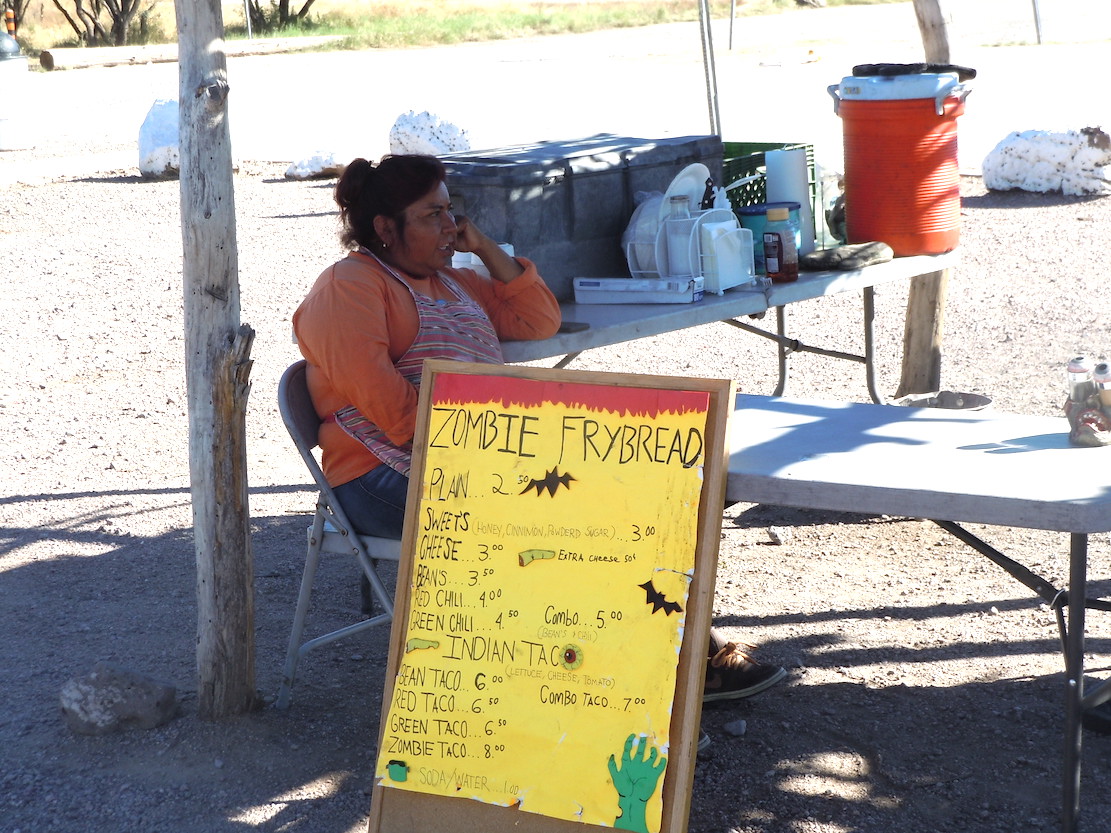
“We’ll
do a fry bread for sure. It’s not a native food; it was
the supplies given to the Cherokee to survive when they
got kicked out: sugar, flour and lard. It’s a symbol of
a really sad time — it was the fry bread that caused
obesity and diabetes. We won’t deep fry it — we want to
treat it ‘to order’ so it’s really fresh and sear it on
the plancha and bake it in the hearth."--Sean Brock on
his new Greenville SC restaurant. Eater.com (11/28/17)
Any of John Mariani's books below may be ordered from amazon.com.
 The
Hound in Heaven (21st Century Lion Books)
is a novella, and for anyone who loves dogs,
Christmas, romance, inspiration, even the supernatural, I
hope you'll find this to be a treasured favorite.
The story concerns how, after a New England teacher,
his wife and their two daughters adopt a stray puppy found
in their barn in northern Maine, their lives seem full of
promise. But when tragedy strikes, their wonderful dog
Lazarus and the spirit of Christmas are the only things
that may bring his master back from the edge of
despair.
The
Hound in Heaven (21st Century Lion Books)
is a novella, and for anyone who loves dogs,
Christmas, romance, inspiration, even the supernatural, I
hope you'll find this to be a treasured favorite.
The story concerns how, after a New England teacher,
his wife and their two daughters adopt a stray puppy found
in their barn in northern Maine, their lives seem full of
promise. But when tragedy strikes, their wonderful dog
Lazarus and the spirit of Christmas are the only things
that may bring his master back from the edge of
despair. WATCH THE VIDEO!
“What a huge surprise turn this story took! I was completely stunned! I truly enjoyed this book and its message.” – Actress Ali MacGraw
“He had me at Page One. The amount of heart, human insight, soul searching, and deft literary strength that John Mariani pours into this airtight novella is vertigo-inducing. Perhaps ‘wow’ would be the best comment.” – James Dalessandro, author of Bohemian Heart and 1906.
“John Mariani’s Hound in Heaven starts with a well-painted portrayal of an American family, along with the requisite dog. A surprise event flips the action of the novel and captures us for a voyage leading to a hopeful and heart-warming message. A page turning, one sitting read, it’s the perfect antidote for the winter and promotion of holiday celebration.” – Ann Pearlman, author of The Christmas Cookie Club and A Gift for my Sister.
“John Mariani’s concise, achingly beautiful novella pulls a literary rabbit out of a hat – a mash-up of the cosmic and the intimate, the tragic and the heart-warming – a Christmas tale for all ages, and all faiths. Read it to your children, read it to yourself… but read it. Early and often. Highly recommended.” – Jay Bonansinga, New York Times bestselling author of Pinkerton’s War, The Sinking of The Eastland, and The Walking Dead: The Road To Woodbury.
“Amazing things happen when you open your heart to an animal. The Hound in Heaven delivers a powerful story of healing that is forged in the spiritual relationship between a man and his best friend. The book brings a message of hope that can enrich our images of family, love, and loss.” – Dr. Barbara Royal, author of The Royal Treatment.
 |
The Encyclopedia of American Food and Drink by John F. Mariani (Bloomsbury USA, $35) Modesty forbids me to praise my own new book, but let me proudly say that it is an extensive revision of the 4th edition that appeared more than a decade ago, before locavores, molecular cuisine, modernist cuisine, the Food Network and so much more, now included. Word origins have been completely updated, as have per capita consumption and production stats. Most important, for the first time since publication in the 1980s, the book includes more than 100 biographies of Americans who have changed the way we cook, eat and drink -- from Fannie Farmer and Julia Child to Robert Mondavi and Thomas Keller. "This book is amazing! It has entries for everything from `abalone' to `zwieback,' plus more than 500 recipes for classic American dishes and drinks."--Devra First, The Boston Globe. "Much needed in any kitchen library."--Bon Appetit. |
"Eating Italian will never be the same after reading John Mariani's entertaining and savory gastronomical history of the cuisine of Italy and how it won over appetites worldwide. . . . This book is such a tasteful narrative that it will literally make you hungry for Italian food and arouse your appetite for gastronomical history."--Don Oldenburg, USA Today. "Italian
restaurants--some good, some glitzy--far
outnumber their French rivals. Many of
these establishments are zestfully described
in How Italian Food Conquered the World, an
entertaining and fact-filled chronicle by
food-and-wine correspondent John F.
Mariani."--Aram Bakshian Jr., Wall Street
Journal.
"Equal parts
history, sociology, gastronomy, and just
plain fun, How Italian Food Conquered the
World tells the captivating and delicious
story of the (let's face it) everybody's
favorite cuisine with clarity, verve and
more than one surprise."--Colman Andrews,
editorial director of The Daily
Meal.com. "A fantastic and fascinating
read, covering everything from the influence
of Venice's spice trade to the impact of
Italian immigrants in America and the
evolution of alta cucina. This book will
serve as a terrific resource to anyone
interested in the real story of Italian
food."--Mary Ann Esposito, host of PBS-TV's
Ciao
Italia. "John Mariani has written the
definitive history of how Italians won their
way into our hearts, minds, and
stomachs. It's a story of pleasure over
pomp and taste over technique."--Danny Meyer,
owner of NYC restaurants Union Square
Cafe, The Modern, and Maialino.
|
 |
 |
 |
 |
 |
 |
 |
 |
 Everett Potter's Travel Report:
Everett Potter's Travel Report: 
 Eating Las Vegas
JOHN CURTAS has been covering the Las Vegas
food and restaurant scene since 1995. He is
the co-author of EATING LAS VEGAS – The 50
Essential Restaurants (as well as
the author of the Eating Las Vegas web site: www.eatinglasvegas.
He can also be seen every Friday morning as
the “resident foodie” for Wake Up With the
Wagners on KSNV TV (NBC) Channel 3 in
Las Vegas.
Eating Las Vegas
JOHN CURTAS has been covering the Las Vegas
food and restaurant scene since 1995. He is
the co-author of EATING LAS VEGAS – The 50
Essential Restaurants (as well as
the author of the Eating Las Vegas web site: www.eatinglasvegas.
He can also be seen every Friday morning as
the “resident foodie” for Wake Up With the
Wagners on KSNV TV (NBC) Channel 3 in
Las Vegas.

MARIANI'S VIRTUAL GOURMET
NEWSLETTER is published weekly. Editor/Publisher: John
Mariani.
Editor: Walter Bagley. Contributing Writers: Christopher Mariani,
Robert Mariani, Misha Mariani, John A. Curtas, Geoff Kalish, Mort
Hochstein, and
Brian Freedman. Contributing Photographer: Galina
Dargery. Technical Advisor: Gerry McLoughlin.
To un-subscribe from this newsletter,click here.
© copyright John Mariani 2017

